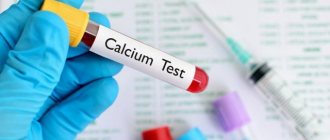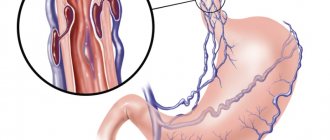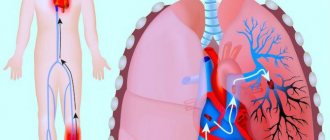Lack of calcium in the blood
04.10.2018
It is impossible to overestimate the role of calcium in our body. Of course, the vast majority of this element is concentrated in the bone tissues of our body, but its small part (only one percent of the total volume) plays an important role in the biochemical processes of the cells of our body. You should know that calcium in the human body is concentrated either in bone tissue or in the blood . There are certain norms for the concentration of calcium in the blood and any deviations to a greater or lesser extent are fraught with negative consequences. An excess of calcium is characterized as hypercalcemia, and a deficiency is called hypocalcemia.
In the blood , calcium is found in free form or in combination with albumin or anions. The total amount of calcium in the blood of an adult averages 350 milligrams, approximately 45% of this volume forms a bond with albumin, approximately five percent is associated with anions and half of the total calcium in the blood is in ionized (free) form. Ionized calcium plays a huge role in blood . Let's take a slightly simplified look at this process.
When the vascular wall is damaged as a result of external factors, thromboplastin is released from the affected endothelium, which, with the direct participation of calcium ions, activates prothrombin, under the influence of which fibrin begins to form from dissolved fibrinogen, leading to retraction of the blood and blockage of the damaged area.
The main causes of calcium deficiency in the body are:
- insufficient synthesis of calcitonin;
- vitamin D deficiency;
- diseases of the gastrointestinal tract accompanied by impaired absorption of the element;
- urolithiasis disease;
- physical inactivity;
- increased sweating ;
- hypocalcium diet ;
- aggressive influence of external factors, for example, systematic contact with phosphate fertilizers.
The resulting lack of calcium in the body is often accompanied by the following symptoms: the endocrinologist bone pain begins to appear , relatively minor injuries can lead to fractures, teeth , memory deterioration is observed, and heart rhythm disturbances appear. Lack of calcium in children leads to disturbances in the formation of the skeleton and slow growth. During pregnancy , due to a lack of calcium, intrauterine growth retardation of the child is diagnosed, and toxicosis may occur. It is worth noting that symptoms appear at the stage of severe calcium deficiency in the human body. It is also very important that a decrease in proteins, usually albumin, in the blood inevitably reduces the level of calcium in it.
to determine the level of ionized calcium in the blood using vitamin D, which is directly related to the amount of calcium and is responsible for its absorption through the tissues of the gastrointestinal tract. The lack of a mineral in the body is compensated for by medication and dietary methods. Diets are based on eating foods high in calcium. It is hardly worth listing the entire list of products; we will highlight only the main ones. These include dairy products, green vegetables, leafy greens, legumes, nuts, sesame seeds, sunflower seeds, and canned fish with soft bones . Be sure to minimize the consumption of foods and drinks that interfere with the absorption of calcium. Drinks that impair the absorption of calcium include coffee, carbonated drinks and alcohol.
Published in Endocrinology Premium Clinic
Bone pain due to osteoporosis
Osteoporosis is a disease that leads to the destruction of bone tissue, the first sign of which is bone pain. Its cause is metabolic disorders, so for bone pain of unknown origin, the diagnosis can be clarified using blood tests.
Where does calcium go?
Bone consists of a mesh protein “skeleton”, in the cells of which calcium and phosphorus salts are deposited. This is precisely what explains its strength: if the bone were simply hard, it would be as fragile as porcelain, but the protein base gives it the necessary flexibility. In the process of human development - starting from the prenatal period - a flexible “matrix” of the future bone is first formed, and it is filled with calcium later. The level of calcium saturation in bone varies at different periods of life. Why does this depend?
The thing is, keeping our skeletons strong isn't calcium's only concern. It is necessary for muscle contraction, including the heart. Therefore, a decrease in the level of calcium in the blood below a certain “subsistence level” is quite rightly considered by the body as a life-threatening situation. And the skeleton is a huge “reserve” of calcium, from which it can be taken if necessary.
Treatment of hypercalcemia
In certain cases, drug treatment is not prescribed. This applies to cases where the calcium level does not greatly exceed the permissible normal limits. In such a situation, it is enough to discuss the correction of the diet, including the list of prohibited foods, which include:
- milk;
- cheese;
- cottage cheese;
- yogurt;
- kefir;
- nuts.
After a certain period of time, the patient will be scheduled for a repeat blood test. It will show whether its composition has returned to normal or not.
In more severe situations, diuretics may be prescribed, provided that kidney function is not impaired and the body is not at risk of dehydration. It is important to strictly adhere to the dosage, because such drugs lead to a sharp decrease in blood pressure.
If the excess calcium is caused by a serious health problem, the patient will be hospitalized for medical attention.
Use of calcium for hypocalcemia and other conditions[edit | edit code]
Calcium is used to compensate for the deficiency of this substance, and also as a dietary supplement. Calcium salts serve as a specific means of emergency treatment of hypocalcemic tetany, regardless of its etiology. For severe tetany, calcium salts are administered intravenously. For hypocalcemic tetany and laryngospasm, calcium chloride (CaCl2 x 2H20), containing 27% calcium, is usually used. It is administered intravenously, avoiding contact with tissue. Injections of calcium chloride are accompanied by dilation of peripheral blood vessels and a burning sensation of the skin. For intravenous administration, a 10% solution with a calcium concentration of 27 mg/ml (0.68 mmol/ml) is usually used. To avoid cardiac arrhythmias, the solution should be administered slowly (no faster than 1 ml/min). In this case, a slight decrease in blood pressure due to vasodilation is possible. Since calcium chloride acidifies urine, it is contraindicated in hypocalcemia caused by renal failure. Calcium glucoheptonate is administered intravenously for severe hypocalcemic tetany in a dose of 5-20 ml of a 22% solution with a calcium concentration of 18 mg/ml (0.45 mmol/ml). If administered too quickly, a temporary tingling sensation may occur. If intravenous administration is not possible, a solution of up to 5 ml is administered intramuscularly, which may cause a mild local reaction. A good source of calcium is calcium gluconate, a 10% solution of which contains 9.3 mg/ml (0.23 mmol/ml) calcium. IV administration of calcium gluconate is the mainstay of treatment for severe hypocalcemic tetany. For moderate and severe hypocalcemia, calcium gluconate is administered as an infusion at a rate of 10-15 mg/kg calcium over 4-6 hours. It is necessary to use many ampoules, since ordinary ampoules with a 10% solution have a volume of only 10 ml and contain 93 mg of calcium . Calcium gluconate cannot be administered intramuscularly, as there is a high risk of abscess formation at the injection site.
For mild symptoms of hypocalcemia, oral calcium is sufficient, usually in combination with vitamin D or one of its active metabolites. There are many calcium salts available for oral use. For hypocalcemia, the average dose is for calcium gluconate - 15 g / day (in fractions), for calcium lactate - 4 g / day (in fractions, with meals; lactose is taken simultaneously with calcium, 8 g / day), for calcium carbonate or phosphate - 1-2 g/day (in fractions, during meals).
In order to limit the absorption of phosphate in chronic renal failure and oxalate in chronic inflammatory bowel diseases, calcium carbonate or calcium acetate is prescribed orally. Rapid administration of calcium can be life-saving in severe hyperkalemia. Calcium gluconate (10-30 ml of a 10% solution) can temporarily reverse some of the cardiotoxic effects of hyperkalemia while efforts are made to reduce plasma K+ concentrations.
The use of calcium supplements for the prevention and treatment of osteoporosis is discussed: Osteoporosis.
4.Treatment
The most effective and natural way to restore the optimally required calcium concentration is a fortified diet. It should, however, be understood that any diets, like all other treatment regimens, activities, procedures, can be developed and prescribed exclusively by a doctor.
The same applies to special calcium-containing supplements and drugs intended for the treatment of the most severe cases of calcium deficiency: such drugs can only be used as prescribed by a doctor.
2. Reasons
The definition of “nutritional” (food) implies and reflects the main cause of calcium deficiency: insufficient dietary intake. The largest amount of calcium available for absorption is found in dairy products (especially cottage cheese and butter), seafood, eggs, and vegetables. Since calcium is biochemically related to vitamin D, a lack of the latter most often leads to calcium deficiency; Thus, the reasons should also include insufficient exposure to the open sun.
The most significant risk factors include smoking, situations of chronic stress, long-term use of certain medications (cytostatics, antiparoxysmal drugs, etc.).
Visit our Therapy page








